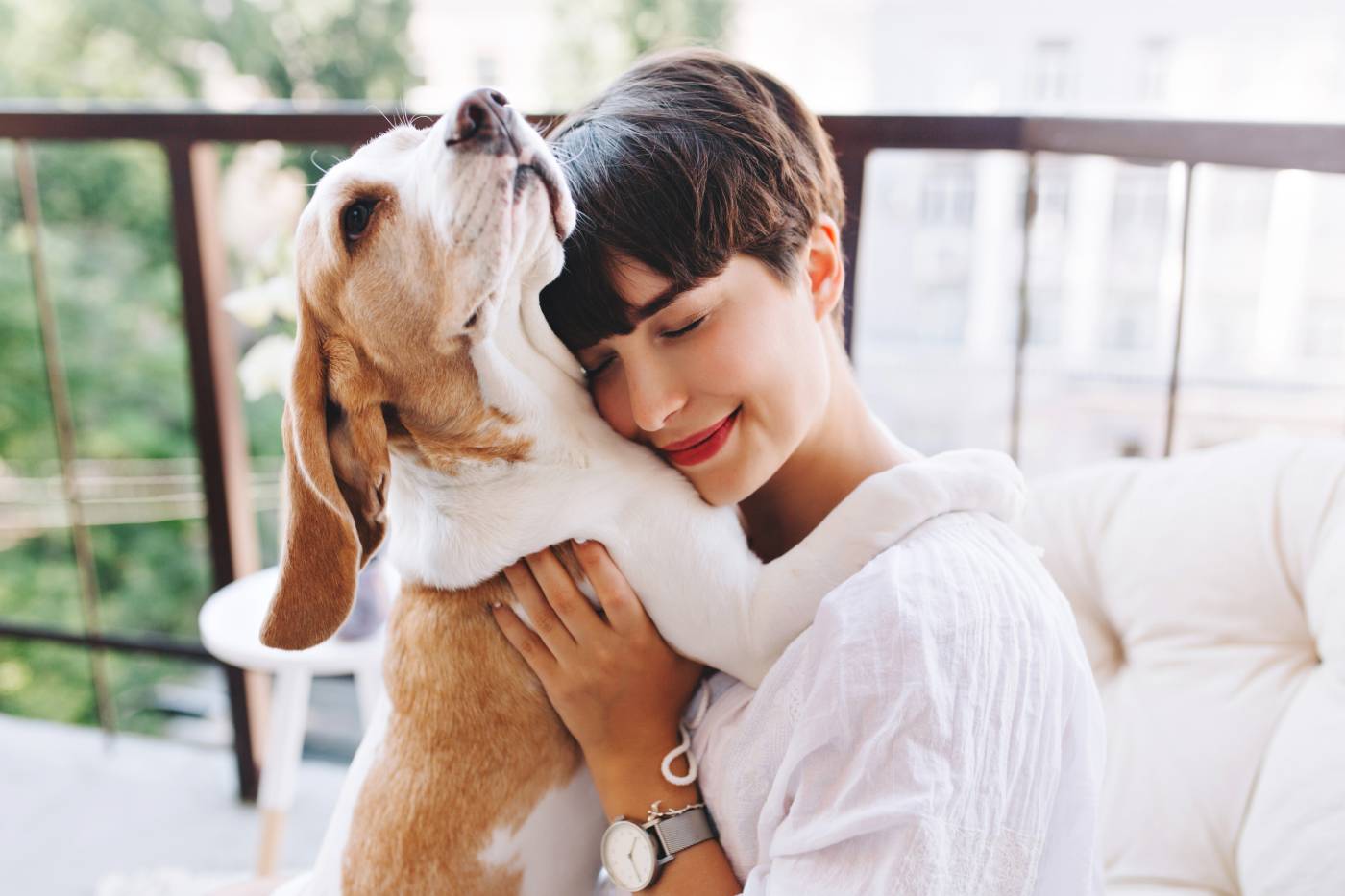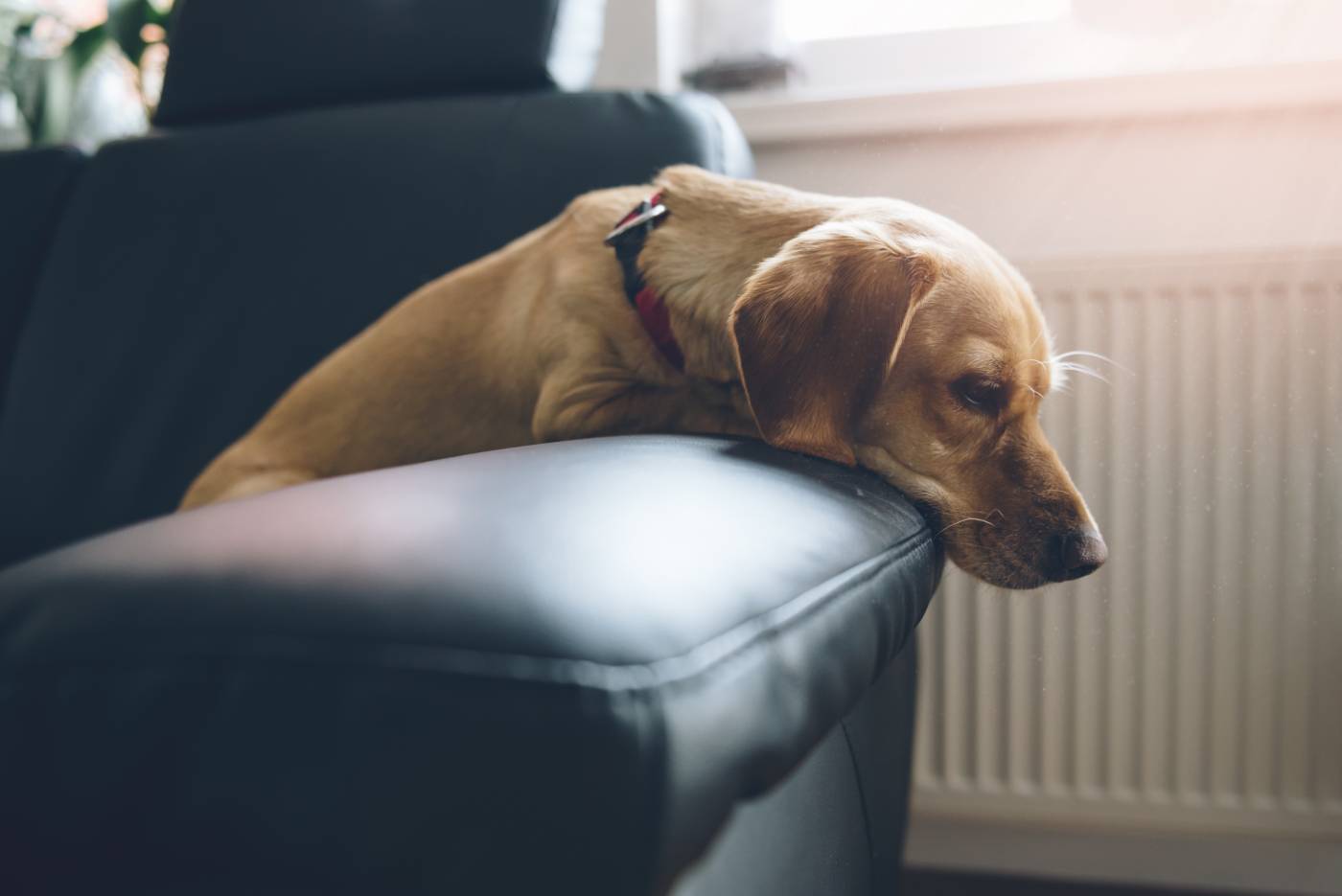Separation anxiety is one of the most common behavioral problems in dogs, and it’s not easy to correct. Dog parents complain that when their dogs are left alone, they howl and bark to excess, have indoor “accidents” even though they are potty trained, and chew things up. So, what causes separation anxiety and how do you help your dog overcome it?
What is separation anxiety?
Separation anxiety is a serious condition. Dogs who suffer from it find it impossible to stay alone at home, and this creates problems not only for them, but also for their owners and neighbors.
3 major signs of separation anxiety
The major symptoms of separation anxiety are:
- Excessive howling, barking, or whining when left home alone
- Destructive behavior (like chewing things up or digging holes)
- Urination or defecation indoors when left alone
To diagnose an anxiety disorder in a dog, at least two of these behaviors must be present. Keep in mind that separation anxiety is not a dog acting out or behaving spitefully; this is a disease that requires careful treatment.
Some owners are so annoyed with this behavior that they take their anger out on the dog, but this only makes the problem worse. The dog can’t handle their anxiety on their own, and they can’t stop this behavior without your help.
Do not confuse separation anxiety with other problems, such as boredom or unintentional learning, which occurs when owners unknowingly reinforce the dog’s howling.
To understand why your dog whines or howls when left alone, you should install a video camera. Excessive salivation, vomiting, sometimes diarrhea and/or self-harm (for instance, a dog biting themselves) can be additional signs of separation anxiety.
What causes separation anxiety?
There are several hypotheses about the causes of separation anxiety in dogs:
- Attachment disorder. A dog with an unhealthy type of attachment is constantly on their guard and feels an insurmountable need to follow their owner like a shadow. Such dogs get very nervous when left alone.
- Some phobias may result in separation anxiety. For example, research has shown that half of all dogs with separation anxiety also suffer from noise phobias (the fear of loud sounds).
- Stress. Proponents of this theory believe that it is necessary to treat distress, no matter what causes it.
Anxiety disorders can manifest themselves to varying degrees and depend on many factors.
The age of separation anxiety onset may depend on the dog’s breed. For example, in labradors, it often begins to develop at 6 months and in border collies at 12. However, there can be differences in bloodlines within a single breed.
Sometimes a dog starts howling at home and their owner weans them off of it in a few days. However, when the environment changes, (for example, after moving to another apartment) the dog may start howling again. They may get nervous, start salivating a lot, destroy everything in the house… New conditions can cause latent separation anxiety to emerge or reemerge.

Because this is sometimes the case, some may think that only external conditions are to be blamed. Dog handlers or breeders may believe that the owners themselves are at fault as they did not provide the puppy with necessary care, but different dogs can react very differently to identical situations.
Separation anxiety is not the result of disobedience, spite, or bad manners. Many dog owners are offended, angry, and rude to their anxious dogs, believing that they howl deliberately to take revenge on them for leaving. A dog with an anxiety disorder cannot just stop howling or engaging in other destructive behaviors when you tell them to.
If your dog is dealing with separation anxiety, don’t blame yourself or your dog. Focus on helping them feel comfortable and secure with or without you.
Are there any breeds that are prone to separation anxiety development?
Separation anxiety is most frequent in small or medium-sized breeds. Cocker spaniels, Springer spaniels, long-haired and smooth-haired dachshunds, Jack Russell terriers, Tibetan spaniels, and beagles are especially prone to it.
Separation anxiety is also quite frequent in some large-sized breeds such as labradors, German shepherds, border collies, gordon setters, golden retrievers, and dalmations.

Separation anxiety may also occur in crossbreeds of the above-listed breeds. Males are more susceptible to this disorder than females.
In more than 70% of cases, anxious dogs live in families.
Is excessive howling always a symptom of separation anxiety?
Dogs may howl or bark for different reasons when they are left alone at home:
- A dog can bark at neighbors that they hear through the door or dogs that they see through the window.
- A puppy can bark for the first ten minutes when left alone at home or in the room. This is a way that the puppy gives a signal: “Hey! I am stuck here! Please come back and help me to get out so that I can go with you.”
- Dogs may howl and bark simply out of boredom if listening to the echo of their voice is the only entertainment available to them. If this gets them attention from a neighbor or another dog, they may end up training themselves to bark excessively.
If you are not sure about the reason that causes your dog’s excessive barking or howling, watch your dog through a security camera. There are a wide variety of mobile apps to help.
Let’s take a more thorough look at the major causes of excessive howling and barking.
A dog barks through the door or a window
This behavior is completely natural for dogs, and it can be both desirable for dog parents (“Well done, good job guarding the apartment”) or unwanted (“Oh, the neighbors have come again.”).

But what exactly is your dog supposed to do when they are left alone and bored? If you want them to sleep when you are away, put their bedding in the hallway so that it is comfortable and cozy for your dog to lie there and so that they can see the door (dogs always want to be near you as quickly as possible when you get home).
You can also leave some chew toys and treats, like deer antlers or bully sticks, with your dog. They’ll keep your dog busy for quite a while. You can also leave a “Kong” toy stuffed with tasty treats. Considering leaving the TV or some music turned on while you’re gone.
If your dog likes to bark through the window, consider making this “observation point” less convenient for your dog. Maybe you unknowingly put your dog’s bedding too close to the windowsill or put the sofa in such a way that it is very comfortable for your dog to sit by the window. Try making their vantage point less accessible.
A puppy is crying for help
A puppy who calls to you for help, as well as an adult dog who grabs your clothes to prevent you from going out the door, does not understand that you intend to come back.
In this case, you run the risk of accidentally encouraging your dog by returning to their call to check on them. This is another reason to use the camera. This way you can take a look at what’s going on and make sure that your dog is fine and that there is no point in returning home.
A dog barks out of boredom
If your dog barks out of boredom, make
sure that the five freedoms of a dog are
present in their life. The five freedoms
will likely either end or significantly
decrease your dog’s barking.
Think about what entertainment you can add to your dog’s life. It’d be impossible for your dog to bark and chew deer antlers or play at the same time.
On the other hand, maybe something reinforces your dog’s bad habit. For example, when barking, your dog can hear a neighbor shouting “Shut up! Stop it!” or a response from another dog behind the fence. In this case, you’d probably need to move your dog to another part of the yard or put them on the terrace so that your pet doesn’t link excessive barking to increased attention.
How do you help your dog cope with separation anxiety?
If you’ve determined from your video camera that your dog likely has separation anxiety, there are several ways to train your dog to stay home alone without feeling nervous or stressed out:
- First of all, make sure your dog’s living conditions are good. A dog cannot behave normally in abnormal conditions. If you do not provide your pet with the five freedoms necessary for a normal life, any behavior correction is doomed to fail at the first step.
- Use relaxation techniques. First, teach your dog to relax in the calmest environment possible and then in the stimuli-saturated one.
- Train your dog to stay home alone gradually. First, train your dog to stay in a room with an open door, then in a room with a closed door, then in the apartment. You can use special exercises aimed at teaching your dog to keep calm when left alone (more on those later). You can also talk to a dog behavior specialist who can help you choose the best techniques.
- Sometimes separation anxiety requires medical treatment. Your veterinarian can choose the right medications that will help address the problem. Under no circumstances should you purchase medication without consulting a vet.
Never punish your dog for their separation anxiety behaviors; this will only increase their anxiety and make the problem worse.
If your dog can’t stand being home alone because of separation anxiety, be patient: it takes quite a lot of time, love, and patience to solve this problem. Some owners even find it easier to change the dog’s living conditions so that they are never left alone, like by hiring a dog sitter or asking friends or relatives to look after the dog.

Keep in mind that separation anxiety can return, even if it seems that your dog has put it behind them. Don’t despair – if you have dealt with the problem once, it is likely that you will be able to help your pet again.
How do you stop your dog’s separation anxiety howling?
The best solution is to address a dog behavior specialist and follow their recommendations.
Before starting behavior correction, you should carefully review your dog’s living conditions. Generally, dogs act normally if they live in normal and satisfactory conditions. So without normalizing the dog’s living conditions, any behavioral correction is doomed to failure.
There are also some simple and effective exercises that are aimed at preventing a dog from barking or howling. Don’t react to your dog’s barking and howling; repeat these exercises until you see their behavior improve. Gradually, with each repetition, your dog will behave more calmly and feel more relaxed.
Exercises aimed at stopping your dog’s howling
-
Start this exercise not near the
front door, but near an interior door.
Set a timer or alarm so that it rings
every minute. Leave your dog in a room
and ask your dog to “stay here.” Some
behaviorists advise using the “sit” or
“down” command, but we believe that
these commands may confuse a dog, as
they may have different associations
that could interfere with their
effectiveness in treating separation
anxiety. Don’t close the door. Leave
the room and take a step away from the
door. Your dog should stay in the
room, and you should stay at the
entrance to the room. If your dog
starts going towards you, immediately
go to it and gently push them into the
room. Once they are there, say
“stay here” again and take
a step back and stand at the entrance
again. After a few repetitions, your
dog will get what you want from them,
and they will stay inside the room. As
soon as the alarm clock goes off, come
to the dog, praise them, and give them
a treat. Set the timer again for 1
minute. Stay in the room with your dog
until the timer goes off again.
Praise your dog and give them a treat
after an alarm clock sound. Set the
timer again, say “stay
here!” and leave the room for 1
minute.
In this exercise, you are together with your dog for one minute, and for one minute you are separated by a threshold (but not a door!). Be sure to set a timer: your dog will learn to wait for its signal. After each signal, praise and give your dog some treats, no matter if they were silent or not. This exercise should be repeated until the dog begins to remain completely calm in the room, without crossing the threshold or trying to get out. On average, this will require 10 minutes of training 2-3 times a day for 1-3 days. - Repeat the same exercise, but now give the treat just before you go out the door.
- Repeat this exercise, but now, close the interior door. Don’t forget to give your dog a treat consistently before leaving the room but after the timer rings. If your dog starts scratching or whining, wait for the timer to ring, enter the room, and then repeat the previous exercise 2-3 times. If after that, your dog tries to scratch the closed door again, combine these exercises with the desensitization exercises, returning to the first step.
- Repeat the exercise with an open front door (the threshold is between you and your dog).
- Then repeat the same exercise (with a timer, minute after minute, giving a treat before you go out) with the front door closed.
- Now slightly increase the intervals by setting the timer for two minutes. Spend two minutes together with your dog, then two minutes apart for a total of three times with your dog and three times without them (12 minutes). In a day or two, do the same exercise, setting the timer for five minutes. Stay with your dog twice and go out twice for a total of 20 minutes.
- Lastly, don’t set a timer; just keep track of time by your watch. Leave your dog for two minutes, come back, and praise them. Then wait with them for one minute. During this time, you can look at the phone, read a book – do anything but interact with the dog. Go out for ten minutes, come back and praise your dog. Wait again for one minute. Go out for three minutes, come back and praise your dog. Go out for twenty minutes, come back and praise… Go out for two minutes… and so on. The idea now is not to increase the time of your absence little by little but to make the intervals of your absence unpredictable.
You won’t believe your ears when you start to come home without the sounds of whining and scratching! You and your dog will have accomplished a major feat.
Desensitization exercises
These exercises will help your dog learn to stay calm and relaxed in general, which can be extremely helpful for dogs with separation anxiety.
- Leave your dog on a mat. Lure them to lie down with a hand gesture from the nose to the floor between their paws. This is similar to teaching the “down” command. Some canine specialists give a dog a treat after they lie down and then give them another treat, bringing their hand close to the dog’s stomach. This makes the dog bend and lie on their side, finding themselves in a more relaxed position.
- Stand up and praise your dog in a calm voice if they don’t jump up. Bend over and give your dog a treat from your hand, so that they remain in a relaxed position. If your dog jumps up, do not praise them, instead encourage them to lay down again. Repeat the exercise once again.
- Then sit near your dog and count to ten. Calmly praise your dog if they continue lying down and give them a treat. If your dog jumps up, lure them down again and praise them.
- Then sit for a longer period of time, praise your dog, and give them a treat. During this stage, after sitting for a while, get up, take a walk around the room, praise your dog, return to them, and then give them some treats. Gradually, move farther and farther to the door, cross the threshold, and wait a minute at the threshold. Repeat each stage several times. Each time the dog jumps up or lies down more tensely, put them back and move back to the previous stages.
Also, as in the exercises described above, you can teach your dog to stay in the room when you stand at the door, then when the door closed, then at the front door and then at the closed front door. The differences here are that there is no need to set a timer and that the dog gets the level of “stimulation” that they are able to accept without starting to worry. If your dog starts to worry, move back to the previous stages and repeat them until your dog feels totally comfortable.
Desensitization exercises last an average of 15 minutes per day. Usually, you’ll spend the most time mastering the first stages. The further you go, the less often your dog starts to worry and the less often you have to take a step back.
Desensitization protocol is very effective, however it is quite time-consuming, and it’s easy for an owner to make mistakes. We advise working on desensitization exercises under the supervision of an experienced specialist.
Once you see positive changes, you can gradually decrease desensitization exercises. If your dog doesn’t howl for two weeks, you can stop them entirely.
Should you punish your dog for having separation anxiety?
After practicing the mentioned exercises, your dog may be silent at home alone for a while and then start howling again. Currently, all canine behaviorists agree that punishment is absolutely useless for treating separation anxiety and that it may even make the matter worse.
What should you do if your dog continues howling after two months of training?
If you don’t see any positive changes in your dog’s behavior after two months of training, think about the mistakes you could possibly be making. Does your dog get enough physical activity? Did you get frustrated and punish your dog on your return? Did you do the exercises correctly? Did you train regularly enough? If you are sure that everything was done correctly, consider contacting a veterinarian and trying to get a drug prescription for behavioral correction. Then you can try combining drugs with your ongoing training.
Should you give drugs to your dog with severe separation anxiety?
You can only give your dog drugs under a veterinarian’s supervision. There are many side effects, such as hypersalivation, loss or increase of appetite, apathy or, conversely, overexcitement. Sudden discontinuation of treatment can also lead to regress. Usually, drug therapy for separation anxiety is carried out for one year. Then, if the behavior correction is successful, the veterinarian begins to gradually reduce the dose of the drug that the dog receives, and then tries to eliminate it entirely. If the problem returns, the drug therapy continues. Many dogs have to take drugs all their life or until the side effects become too dangerous. You should not forget to do blood and hormone tests as prescribed by a doctor (usually once a year).
What do you do if your dog’s separation anxiety returns?
Every dog that is prone to separation anxiety has their own triggers. For many dogs, triggers include changing homes, having guests visiting, being introduced to new family members, or increasing periods when the dog is left without their owner. Some dogs start howling again in spring or in autumn, while for others it’s more likely during hormonal surges (the eve of estrus for females and the presence of a female in heat for males).

If your dog starts howling again, immediately repeat all the exercises with them. You probably won’t have to do many repetitions; you’ll need to just briefly go through all the steps. Of course, try to protect your dog from triggers if possible.
How to live with a dog that has separation anxiety
You need to live their life and not postpone things because your dog cannot stay home alone. If you cannot fix your dog’s separation anxiety, think about how you can adapt to it. Day care services are getting more and more popular nowadays, and it may turn out that paying for a facility where your dog can spend time playing with other dogs and interacting with canine specialists is much more beneficial for your nervous system and wallet than choosing to work remotely and refusing to meet with friends. If there’s no facility that can provide your pet with day care in your city, you may find a retired person or a freelancer working from home who can take care of your dog in your absence for a reasonable fee.
Canine separation anxiety is a difficult issue for pets and pet owners alike. But there are strategies that you can use to help both of you be happier and healthier together.
